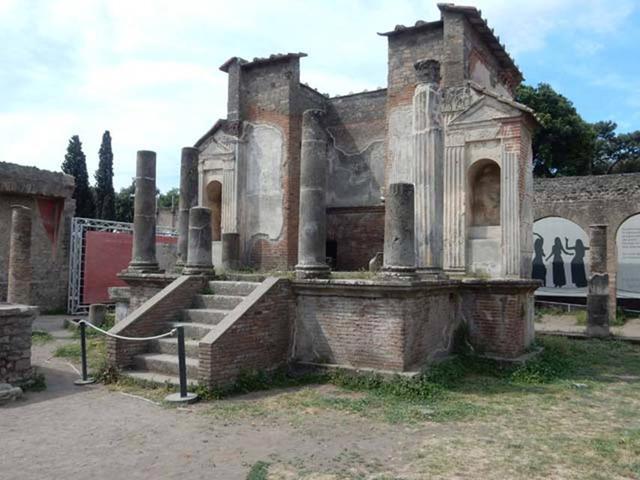Temple of Isis

The Temple of Isis in Pompeii is a fascinating archaeological site that dates back to the 2nd century BC. This ancient temple was dedicated to the Egyptian goddess Isis, whose cult had a significant presence throughout the Roman Empire. The temple's entrance, located on the south side of the Via del Tempio d'Iside, features a dedicatory inscription commemorating its reconstruction following the devastating earthquake of 62 AD. The reconstruction was generously funded by Numerius Popidius Ampliatus, a freedman, on behalf of his son Celsinus.
Upon entering the temple, visitors are greeted by a spacious courtyard surrounded by a four-sided portico. The porch is adorned with intricate decorations in the fourth style, showcasing red panels depicting priests in ceremonial attire, Egyptian landscapes, and architectural motifs. The lower orange frieze features captivating images of lionesses, sphinxes, dragons, and dolphins, while the upper area showcases floating temples and delicate paintings of landscapes and still lifes on a white background.
The National Archaeological Museum of Naples houses all surviving decorations from the Temple of Isis in a series of dedicated rooms (rooms LXXIX - LXXXII and LXXXIV). The temple itself stands proudly on a raised podium at the center of the courtyard, featuring a porticoed entrance with niches on either side leading to the cella. The walls were originally covered in white stucco resembling opus quadratum, with a raised pedestal along the back wall designed to support statues of Isis and Osiris. A statue of Dionysus with a panther, a gift from Numerius Popidius Ampliatus, can be found in a niche at the back of the podium.
To the left of the steps lies the main altar of the temple, with a second altar situated on the south side of the podium. On the east side of the complex, visitors can explore a small temple-like structure known as the Purgatorium. This area was dedicated to purification rites and features a staircase leading to an underground cistern containing the sacred waters of the Nile. The façade of the Purgatorium boasts a broken triangular pediment and a frieze depicting two processions of priests converging towards the center, with reliefs of Mars with Venus and Perseus with Andromeda adorning the outer side walls. The Temple of Isis is a must-see attraction for history enthusiasts and art lovers alike, offering a glimpse into the rich cultural tapestry of ancient Pompeii.
© ChatGPT 3.5